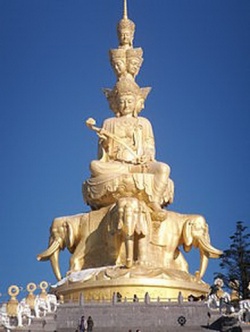Universal Worthy
Universal Worthy
普賢菩薩 (Skt Samantabhadra; Jpn Fugen-bosatsu) Samantabhadra, is a bodhisattva in Mahayana Buddhism associated with Buddhist practice and meditation. Together with Shakyamuni Buddha and fellow bodhisattva Manjusri he forms the Shakyamuni trinity in Buddhism. He is the patron of the Lotus Sūtra and, according to the Avataṃsaka Sūtra, made the ten great vows which are the basis of a bodhisattva. In China, Samantabhadra is associated with action, whereas the bodhisattva Mañjuśrī is associated with wisdom. In Japan this bodhisattva is often venerated by the Tendai and Shingon sects, and as the protector of the Lotus Sūtra by the Nichiren sect. In the Nyingma school of Tibetan Buddhist Vajrayana, Samantabhadra is considered a primordial Buddha in indivisible yab-yum union with his consort Samantabhadri
A Bodhisattva who is regarded as symbolic of the virtues of Truth and practice. In various Sutras, he is depicted as one of the two leading Bodhisattvas who attend Shakyamuni Buddha, the other being Manjushri. He is usually shown on The Buddha's right, riding a white elephant with six tusks. In the "Universal Worthy" (twenty-eighth) chapter of the Lotus Universal Worthy Sutra , he vows to protect the Lotus Sutra and its votaries, saying to The Buddha, "In the Evil and corrupt age of the last five-hundred-year period, if there is someone who accepts and upholds this Sutra, I will guard and protect him, free him from decline and harm, see that he attains peace and tranquillity, and make certain that no one can spy out and take advantage of his shortcomings." In this chapter, he also takes a vow before The Buddha, saying: "I now therefore employ my transcendental powers to guard and protect this Sutra. And after the Thus Come One has entered extinction, I will cause it to be widely propagated throughout Jambudvipa and will see that it never comes to an end." Bodhisattva Universal Worthy is also the protagonist of the Universal Worthy Sutra, which describes his beneficent Power, how to meditate on him, and the benefit accruing from doing so. In the Flower Garland Sutra, Bodhisattva Universal Worthy makes ten great vows concerning his Buddhist practice, such as a vow to bestow all Blessings upon all living beings and lead them to Buddhahood. This Sutra relates the story of the boy Good Treasures who visits fifty-three teachers in search of the Law. Good Treasures finally meets the fifty-third teacher, Bodhisattva Universal Worthy, and on hearing his ten great vows attains Enlightenment. A number of murals from Central Asia and images from China and Japan depicting this Bodhisattva are extant.
Samantabhadra. The word Samanta means, "universally extending." Bhadra means "great virtue." The word samantabhadra means as Universal Virtue and Universal Worthy. This bodhisattvas usually rides on a six-tusked white elephant. The six tusks represent overcoming attachment to the six senses. They also represent the Six Perfection's (paramitas)- charity, morality, patience, diligence, contemplation, and wisdom - or the six ways in which the bodhisattvas pursue their spiritual cultivation so that they may attain enlightenment and save other living creatures. Those who frequently worship Bodhisattva Samantabadhra would gradually receive his blessing and would become energetic and persistent in their practice of the six paramitas.
Like Manjushri, Samantabhadra was an assistant to Sakyamuni Buddha. Historically, there are four famous bodhisattva in the East Asia; each symbolizes the Buddha's emphasis on different aspects of Dharma practices. They are Avalokitesvara's compassion, Manjushri's wisdom, Samantabhadra's practice, and Ksitigarbha's vow. Samantabhadra is also called the Great Conduct Bodhisattva, a name that reflects his practice of Buddhism through his famous Ten Great Vows.
Samantab is a cosmic entity embodying all the bodhisattva practices and merits which must be fulfilled in order to attain Buddhahood. According to the Flower Garland Sutra, bodhisattva practitioners must dedicate all of their efforts to the enlightenment of all sentient beings and sacrifice everything for the welfare of all. In this way, the boundaries of selfhood and the limitation of self-effort are transcended, and one enters into the ocean of merits of all beings, an ocean of merits which is the Samantabhadra's omnipresent body of virtue.
In the Avatamaska Sutra it is recorded that Bodhisattva Samantabadhra makes 10 great vows concerning his Buddhist practice which becomes the leading guidelines of all Bodhisattvas. They are:
1.To venerate all buddhas.
2.To make praises to the infinite number of buddhas.
3.To make offerings to buddhas, the most meaningful offering is to practice the Buddhist teachings so as to benefit oneself and others.
4.To repent and reform all karmic hindrance, accumulated from our thoughts, words, or actions throughout our past reincarnations.
5.To rejoice and join other's merit and virtue.
6.To pray that the Dharma wheel (Buddha's teachings) will be turned (passed on).
7.To petition that the Buddhas remain in the world to benefit more people.
8.To always follow the Buddha's path (teachings) in order to attain enlightenment.
9.To live harmoniously with all living beings. I.e., to respect all sorts of beings, and be as attentive to them as he would to his own parents or even to the buddhas.
10.To reflex all accumulating merits and virtue back to all living beings for their salvation.
The above ten vows conclude the combination of seeking enlightenment for themselves (the first eight vows) and saving others (the last two vows) by helping them attain enlightenment is typical of the vows of bodhisattvas.
A Chines Buddhist monk named Hui-Chih went to O-Mei Mountain in China's Xhsi-Thuan Province in 399 A.D. and built a temple devoted to Samantabhadra. Since then O-Mei Mountain becomes the sacred site of Samantabhadra Bodhisattva. In Japan, Samantabhadra is known as Fugen.
